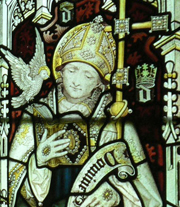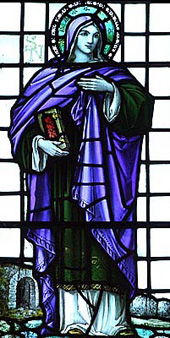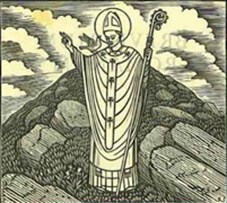Saint David - who was he?
- Worship Resources:
- Articles
 Stained glass image of David in Jesus College Chapel, Oxford (Licensed under Creative Commons)
Stained glass image of David in Jesus College Chapel, Oxford (Licensed under Creative Commons)
Find out more about the man, and then read our Songs for David.
In the life of David (Dewi Sant) recorded by Rhigyfarch around 500 years after the saint’s death, three of his defining characteristics are encapsulated within a single legend. His birth is said to have been foretold to his father, Sanctus, King of Ceredigion, to whom it was revealed by an angel that when he went hunting the next day he would find three gifts.
These gifts would foreshadow Dewi’s life – a honeycomb representing wisdom (just as honey lies embedded in wax so Dewi would perceive spiritual meaning within a literal statement); a fish apparently living only on water representing Dewi’s plain diet and abstinence from alcohol; and the stag he’d hunt down, signifying power over evil, “the ancient serpent”. Non - the mother who was raped (Licensed under Creative Commons)
Non - the mother who was raped (Licensed under Creative Commons)
Sanctus’ role in Dewi’s birth is double-edged, the boy being conceived as the result of Sanctus raping Dewis’ mother, St Non. Born in Mynyw, later renamed St David’s, the boy was educated under Iltyt and, for ten years, Paulinus. The focus of his life would become the training of disciples at a monastery in his birthplace, and the establishment of other monastic foundations, mainly in Wales but also in England’s west country and the east midlands.
Stories of David’s 5th century mission are clearly of a time when older traditions often felt under threat from newer Christian teaching. The “evil” mentioned in his birth legend, for example, is evident in the reported attempts of a local chieftain, Baia, and his wife to rid Mynyw of the David’s holy community. However, Baia, setting out to attack the monks, finds himself powerless to do so; instead, his cattle are unaccountably destroyed. Next, his wife sends her maids to cavort outside the monks’ dwellings; some of the men are tempted to leave the area, but David persuades them that the life of faith demands resistance to temptation. It is Baia’s family that is ruined, while the monastic community thrives.
David demanded a strict discipline, reminiscent of the ancient desert monks. Rhigyfarch describes a routine of labour in the fields (for “carefree rest was the source and mother of vices”), balanced by regular prayer and a simple diet of bread and salted herbs. In one account, David himself is said to have been nourished only by river water and meadow-leek, abstaining from all animal products. The commitment of prospective community members was tested by making them stand outside the monastery doors for ten days before admittance. David preaching at Synod of Brefi (Licensed under Creative Commons)
David preaching at Synod of Brefi (Licensed under Creative Commons)
This was David’s preferred life – but theological controversy drew him into a wider role. Persuaded to attend the Synod of Brefi in 519, David is said to have spoken eloquently from a hill that rose up under his feet, allowing his voice to be clearly heard and for his convictions to overcome those who were following the teachings of Pelagius. Pelagius had over-emphasised the ability of human beings to earn salvation by combatting sinful behaviour, and undervalued God’s grace.
A number of miracles are associated with David, often to do with the restoration of a person’s sight, and once overcoming an attempted poisoning by his own deacon. However, it is his Christian example that evidently impressed those who, like Rhigyfarch, wished to assert his authenticity as a saint. They attributed his consecration as archbishop to the patriarch in Jerusalem, and hailed David as “a doctrine to his hearers, a guide to the religious, a light to the poor, a support to the orphans”.